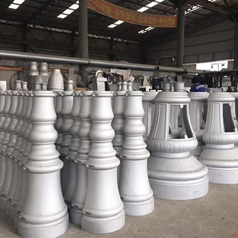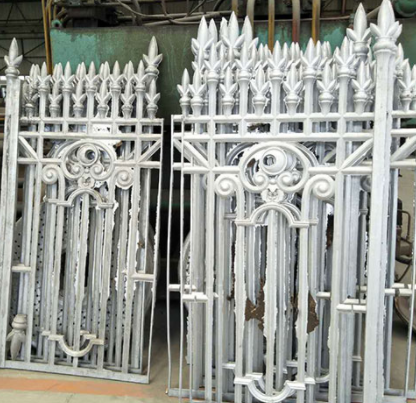Cast iron is a hard-wearing, high-performance metal that is versatile and can be used for everything from garden furniture to gates and railings. Over time, cast iron items develop surface imperfections that add to their character and give them a particularly period-appropriate appearance. While cast iron can last for centuries, poorly maintained parts can begin to rust and deteriorate. Learning how to restore cast iron is critical to giving new life to old items and reducing the need for wasteful replacement.
Whether you have an old cast iron fireplace or plan to install an antique design, it may need some restoration work.
Cast iron fireplaces can be either painted or coated with a protective iron paste or black grate polish - which gives them their signature black finish.
If you're restoring a fireplace that has been damaged or peeling paint, you'll need to remove it with a paint stripper. This is an unpleasant task and requires extra care when handling such harsh chemicals. Do not use a blowtorch as you may release lead from the paint or damage the fireplace.
Apply the paint stripper exactly as directed, let it work for the specified amount of time, and then scrape off the paint with a scraper. You may need more than one application and may need to use a hard brush to get into the details. To remove rust spots or stubborn marks, cut a piece of medium-quality steel wool to rub off the rust, then put on protective gloves and gently remove it until the rust is gone.
To prime your cast iron fireplace for the final finish, use fine steel wool, but avoid cleaning the surface with water. If the surface does become wet, wait until it is completely dry before painting, polishing, or taping.
Left outside and exposed to the elements, cast iron garden furniture will eventually show signs of wear and tear. It is often purchased at antique stores and although it comes with an attractive aged luster, it usually requires some thin layer chromatography to keep it in good condition.
Common problems with cast iron garden furniture include peeling paint, rusted fixing bolts and general dirt and algae on the surface. As with most renovation jobs, the hard work starts at the beginning, which means hours of scraping, sanding, and scrubbing
Rusty bolts need to be removed and replaced.' If a wrench doesn't undo them, spray them with release oil and try again. Tapping with a hammer helps break the corrosion that holds the nuts and bolts together, but be careful doing this on cast iron, which is brittle and prone to cracking.
As a last resort, LianJiang suggests you can use a hacksaw to cut through the strong nuts and bolts. Replace them with new, corrosion-resistant ones.
The next step in restoring cast iron garden furniture is to give it a good cleaning. If any algae are present, they should be sterilized with a brush or sponge for cleaning or bleaching and left for 24 hours before rinsing with water.
If there are only small areas of flaking paint, it's not worth removing all the paint from the garden furniture before applying a fresh coat. Wearing protective gloves, remove the flaking paint with a steel brush to provide a good substrate for the new paint coating.
As the paint wears off, the metal will be exposed to the elements and a powder coat will form. Use sanding blocks and wet and dry sandpaper to work on unstable surfaces until a solid base is achieved.
The final step before painting is to clean the furniture with hot soapy water and then allow it to dry completely before applying the paint. In some cases, you will need to apply a primer first - read the instructions carefully.
Cast iron gates and railings make an important first impression of your home, so if they look tired, restoring them will enhance the entire look.
If the metal has been painted multiple times, fine details can become blurred. Therefore, if too much paint has built up or large areas have rusted, it is usually best to strip away all of the original paint.
The job can be done with a chemical paint stripper. A heat gun can be used, but the old paint may contain lead. If you are using a removable item (such as a door), you can bring it to a professional company.
It is easier to leave it in place and paint over it where there is less paint buildup and only minor flaking.
Use a metal scraper to remove all blistered and flaking paint. Rust spots should be removed with a steel brush, then cleaned with steel wool to a shiny finish. Once all loose paint flaking has been removed, sand the remaining paint edges with sandpaper to avoid unsightly "steps" in the finished paint.
Wipe the metal with a damp cloth and, if necessary, use a rust remover in strict accordance with the manufacturer's instructions.
Make sure the metal is completely dry before applying the metal primer and then apply two fresh coats of paint.
Looking for Cast Aluminum and Iron Part or Casting Tooling Foundry Design Solution? Welcome to contact us. We supply Street Lighting Bases, Street Sign Bases, Fences, Tables, Chairs, Bench Furniture Parts, Mailbox Posts, Garden Decorations, Gates, Fireplace Castings.
 How To Solve The Burr Of Aluminum Castings
Jul. 29, 2024
How To Solve The Burr Of Aluminum Castings
Jul. 29, 2024
 Aluminum Casting 4 Kinds Of The Surface Treatment Pr...
Jul. 09, 2024
Aluminum Casting 4 Kinds Of The Surface Treatment Pr...
Jul. 09, 2024
Copyright © Dalian Lianjiang Metal Co., Ltd. All Rights Reserved | Sitemap
Recommend Products: Aluminum Mailbox With Post
